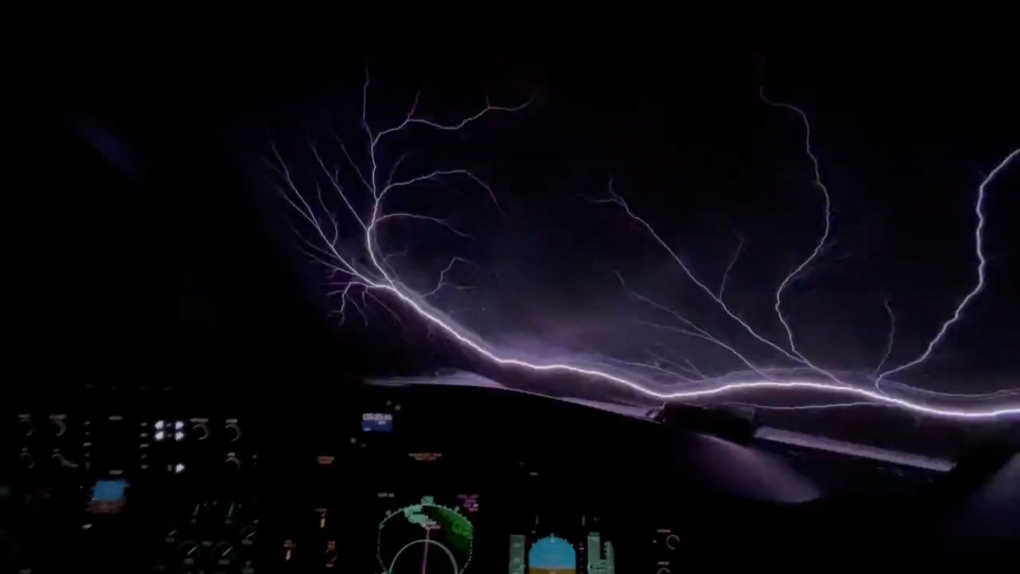St. Elmo's Fire phenomenon caught on camera during flight over central Alberta
Unless you're a pilot, St. Elmo's Fire is probably just some old TV show.
But, it's also the term for a spectacular light show that one CTV News Edmonton viewer (and pilot) caught on camera during an Aug. 23 flight between Edmonton and Calgary.
Dermot O'Kane describes the 45-minute flight at about 16,000 feet as routine. But as the crew passed over central Alberta that night, they saw something anything but ordinary.
"This flash just caught my eye," O'Kane recalled. "I was worried it was lightning and then it happened again and again... And we realized it wasn't far outside. It was straight outside the window."
His captain with 20 years' experience recognized the web of currents for what it was: St. Elmo's Fire.
 (Credit: Dermot O'Kane)
(Credit: Dermot O'Kane)
(Credit: Dermot O'Kane)
With the plane in cruise flight in auto pilot and the captain in control, O'Kane pulled out his phone to record 30 seconds of the luminescent strands flashing along the plane's surface.
St. Elmo's Fire isn't technically lightning, but it looks similar and both are plasmas. Discharges of atmospheric electricity like this can also occur with the masts of sailing ships.
It's quite rare. O'Kane had heard of it but not seen it in his nine years of flying. His captain had only witnessed the phenomenon once.
The pilot and nature photographer had just one word for the experience: "Cool."
The show lasted about 10 minutes and wasn't too distracting, O'Kane said, noting it may have been had they been trying to land.
According to a Popular Mechanics article on the subject, the St. Elmo's Fire term is derived from the name of the patron saint sailors, St. Erasmus of Formia.
CTVNews.ca Top Stories

BREAKING King Charles' cancer treatment progressing well, says Buckingham Palace
King Charles III’s doctors are 'sufficiently pleased' with his cancer treatment and he is expected to return to public-facing duties, Buckingham Palace announced on Friday.
BREAKING Orca calf that was trapped in B.C. lagoon for weeks swims free
An orca whale calf that has been stranded in a B.C. lagoon for weeks after her pregnant mother died swam out on her own early Friday morning.
'Unacceptable': Trudeau reacts after AFN chief says headdress taken from plane cabin
After the Assembly of First Nations' national chief said her headdress was taken from an airplane cabin this week, Prime Minister Justin Trudeau called the incident 'unacceptable' and a 'mistake' on the part of Air Canada.
DEVELOPING Bird flu outbreaks: WHO weighs in on public health risk
The current overall public health risk posed by the H5N1 bird flu virus is low, the World Health Organization said on Friday, but urged countries to stay alert for cases of animal-to-human transmission.
Sophie Gregoire Trudeau on navigating post-political life, co-parenting and freedom
Sophie Gregoire Trudeau says there is 'still so much love' between her and Prime Minister Justin Trudeau, as they navigate their post-separation relationship co-parenting their three children.
Regina police officer injured after being accidentally shot by fellow officer's gun
An investigation is underway after a Regina police officer was accidentally shot by a fellow officer’s gun during the search of a house early Friday morning.
From faulty kids' cribs to flammable kids' bathrobes, here are the recalls of the week
Health Canada issued recalls for various items this week, including kids’ bathrobes, cribs and henna cones.
Taylor Swift dons Montreal designer's dress in 'Fortnight' video
A pair of Montreal designers' work has now been viewed over 41 million times. Taylor Swift dons a Victorian throwback black gown in her latest music video, 'Fortnight', designed by UNTTLD due Simon Belanger and Jose Manuel Saint-Jacques.
Island near Mull of Kintyre for sale for US$3.1 million
An idyllic 453-acre private island is up for sale off the west coast of Scotland and it comes with sandy beaches, puffins galore, seven houses, a pub, a helipad and a flock of black-faced sheep.































